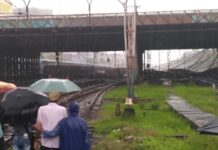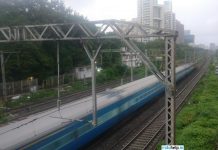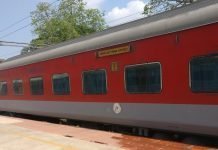Kangra Valley Railway Details
The Kangra Valley Railway lies in the sub-Himalayan region of ✅ Kangra Valley and is a part of India’s five ‘toy trains’. It is Covering a distance of 164 km, the Kangra Valley Railway runs from Pathankot in Punjab, to Joginder Nagar in Himachal Pradesh.
The sensuous hill section of the North is the Pathankot-Joginder Nagar section which is the rail approach to the beautiful Kangra Valley of Himachal Pradesh. Kangra Valley draws not only tourists and nature lovers, it also has a special attraction for the religiously inclined, as it is the earthy abode of several gods and goddesses. The railway line which is a part of the Firozpur division of Northern Railway was commissioned in 1929.
- First Express Train on Kangra Valley Railway Details
- Time Table
- Distances of Popular Tourist spots from this section
- Contact Details
- Kangra Valley Railway Further Details
- FAQ
Railway Plans to Restore Train Services on The Kangra Valley Narrow Gauge Heritage Rail Line
Northern Railway announced that Repair Works Planned for Restoration of Damaged Bridge and to Create Infrastructure for Restoration of Train Services.Kangra Valley Railway provides narrow gauge connectivity from Pathankot-Nurpur-Kangra-Baijnath Paprola – Joginer Nagar. In the current monsoon season, there have been heavy rains in Kangra Valley. This resulted in landslides, boulder falling and flash floods due to which the Railway line was badly affected. As a precautionary measure and considering the history of flash floods, operation of trains on this line was suspended from 14th July 2022.
There is a bridge on river Chakki between Dalhousie Road & Nurpur, numbered as Bridge 32. on 31.07.2022, flash flood in Chakki River resulted in damage to protection works and scouring near Pier No.3. Pier No 3 of the bridge developed a crack above the well cap. This was a result of the river bed of Chakki degrading and the bed level of the river going down rapidly year after year. General Manager, NR held a meeting with the Chief Secretary of Punjab on 16th August 2022 in this connection. A meeting has also been requested between GM, NR and the Chief Secretary of Himachal Pradesh to facilitate the repair works on the rail section.
Subsequently, on 20thAugust, 2022, a cloud burst was experienced in the area leading to abnormally heavy water discharge with high velocity in river Chakki. Protection Works done by the railways to protect the Piers of the bridge suffered extensive damages as the river bed downstream was very low. Over a period from morning to evening, 05 piers of Bridge were washed away and some others rendered unsafe. In all, 7 piers and 6 spans of the bridge are washed away or unsafe and needing repair/replacement.
Indian Railways works with the prime focus of providing safe, secure and timely service to its users. Repairs/Rebuilding of the rail track and the damaged portion of bridge 32 has been planned and will be completed in the shortest possible time.
In the meantime, to serve the rail users, resumption of train services is planned in the unaffected portion of the railway track. Services will be re-introduced between Pathankot-Dalhousie Road and Nurpur Road-Joginder Nagar. In consultation with the State authorities, road bridging between Nurpur Road to Dalhousie Road is being planned for a few services. The schedule for the phase wise and section wise running of train services will be intimated in due course.
Hon’ble MR has reviewed the action plan for resumption of train services and repairs/ reconstruction of bridge 32 with General Manager/Northern and other officers concerned. He has directed resumption of services at the earliest and expeditious repairs/restoration work of the bridge.
First Express Train on Kangra Valley Railway Details
Northern Railway is introducing First Express Train on Kangra Valley Railway (KVR) from 01.02.2019.

Time Table
Time Table of Regular Trains on the Section are:
Pathankot – Joginder Nagar (N.G.)
Actual Distance (Kms.) | Train no.Station | Pass 1PBJ | Pass 1PB | Pass 3PB | Pass 3PBJ | Pass 5PB | Pass 7PB | Pass 1JP |
|---|---|---|---|---|---|---|---|---|
| Pathankot | 0240 | 0430 | 0700 | 0950 | 1255 | 1615 | 1740 | |
| 83 | Jawalamukhi Road | 0553 | 0802 | 1034 | 1334 | 1633 | 2005 | 2120 |
| 94 | Kangra | 0623 | 0832 | 1108 | 1410 | 1758 | 2047 | – |
| 109 | Nagrota | 0702 | 0909 | 1208 | 1526 | 1858 | 2120 | – |
| 127 | Palampur (HP) | 0755 | 0956 | 1303 | 1634 | 1957 | 2156 | – |
| 141 | Baijnath Paprola | 0905 | 1040 | 1350 | 1730 | 2045 | 2245 | – |
| 164 | Joginder Nagar | 1115 | – | – | 1940 | – | – | – |
Joginder Nagar – Pathankot (N.G.)
| Train no. Station | Pass 2 JP | Pass 2PB | Pass 4PB | Pass 2PBJ | Pass 4PBJ | Pass 6PB | Pass 8PB |
|---|---|---|---|---|---|---|---|
| Joginder Nagar | – | – | – | 0720 | 1220 | – | – |
| Baijnath Paprola | – | 0415 | 0720 | 1045 | 1555 | 1410 | 1735 |
| Palampur (HP) | – | 0453 | 0802 | 1127 | 1641 | 1451 | 1817 |
| Nagrota | – | 0537 | 0902 | 1215 | 1729 | 1533 | 1905 |
| Kangra | – | 0618 | 0950 | 1252 | 1805 | 1610 | 1942 |
| Jawalamukhi Road | 0445 | 0657 | 1028 | 1325 | 1833 | 1640 | 2012 |
| Pathankot | 0840 | 1045 | 1430 | 1710 | 2245 | 2110 | 2340 |
Note : Timings are subject to revision. Reservation of seats is not enabled on this section and therefore the tourists are required to occupy available seats on arrival.
Distances of Popular Tourist spots from this section
- Jawaladevi 21 KMs from Jawalamukhi Road station
- Chintapurni Devi Mandir 36 Kms from Jawalamukhi Road station
- Dharamshala(HP) 17 Kms from Kangra station
- Maclodganj 27 Kms from Kangra station
- Kangra Mandir 2 Kms from Kangra Mandir station
- Chamunda Devi Mandir 8 Kms from Palampur Himachal station
Contact Details
- Email: dctg@rb.railnet.gov.in (complaint or suggestion)
- Additional GM (Tourism)/IRCTC/New Delhi : Ph. no. (011) 23701145, 23701101, Fax no. (011) 23701185, 23701177, E-mail:hillcharter@irctc.com
Kangra Valley Railway Further Details
The Kangra Valley Railway (KVR) is a linear Property 163.720 Kilometers long and 0.762 meter wide, which runs from Pathankot (located at an elevation of 383.820 m) to Joginder Nagar (located at an elevation of 1184.160 m), in the Kangra Valley, in the states of Punjab (Gurdaspur District) and Himachal Pradesh (Kangra and Mandi districts), India. The difficult mountain terrain involved the bridging of ravines through which flow the mountain torrents and some of these are noteworthy as engineering marvels. There are also two tunnels. Over its length of 163.720 Kilometers, the KVR ascends at a maximum gradient of 1 in 25, crosses over 993 bridges, runs through two tunnels and winds through 484 curves (sharpest being 300 equal to 58.33 m). This unique line has been constructed skillfully to present to the traveller, a chance to gaze on the ever present panorama of snow-clad ranges and the gold green fields.
The Kangra valley is the region between the Dhauladhar ranges of the Himalayas to the north (a low chain of ridges about 2500 metres high in front and peaks 5000 meters tall behind) and the foothills to the south, about 50 kilometers wide, ascending from West to East and the KVR runs through its entire length. It remains a well known tourist attraction in Northern India. The portion of the line in Gurdaspur and Kangra districts forms the lower section (smoother gradients and curves) and the portion in Mandi district forms the upper section (steepest gradients and curves). The route of the KVR, developed as a cultural corridor and provided access to the Kangra Valley; linking important towns, very holy Hindu pilgrimage centers and settlements. It also, provides access to the Dalai Lama’s abode at Mcleodganj.
The construction of KVR began in 1925 and it was opened on 1st December 1928 for freight traffic for the Uhl hydroelectric project due to which this Railway was constructed. In April 1929, it also, became a passenger Railway. It suffered a disruption during World War II (1941-42) when a portion of its track was dismantled for war material supply but it was restored twelve years later in April 1954. A short portion (about 25 kilometers) of KVR also had to be realigned in 1973 due to the construction of the Pong Dam resulting in a disruption for three years. Despite these disruptions, other natural / technical calamities in high mountainous areas and although the KVR has never been remunerative; it has survived as a cultural asset and the Indian Railways is committed to its conservation for posterity.
A trip on the KVR is a thrilling experience and the best way to savour the beauty of the Kangra Valley. Pathankot is the interchange station, of the broad-gauge main line in Northern India. Broad Gauge trains are connected at Pathankot, and have about 7 pairs of connecting narrow gauge services. The KVR was opened with steam traction and it now being run with diesel locomotives based at Pathankot. However, one original steam locomotive has been restored for KVR and this is also based at Pathankot for heritage steam train service available for chartered train operation. Trains are run at a maximum speed of 45 kmph in the lower section and 20 kmph in the top section (steepest portion).
The railway can be divided into three sections as follows:
- The first section is 12 kilometers long from Pathankot (elevation 383.820 meters) to Chakki Bridge (elevation 398.780 meters); in Gurdaspur district, in the state of Punjab.
- Pathankot has the locomotive shed, carriage sub-depot of the KVR. Starting from Pathankot, the narrow gauge line runs out of the town and crosses the Chakki river in a scenic manner.
- Significant locations and structures along this route include inter-alia the Pathankot station and Chakki bridge.
- The maximum gradient is 1 in 40 that is the maximum gradient in the lower section of KVR.
- The second section is the pilgrim section, 130 kilometers long from Chakki Bridge (elevation 398.780 meters) to Baijnath Paprola (elevation 979.750 meters).
- Significant locations and structures along this route include inter-alia the railway stations, Reyond Khad bridge, Bathu Khad bridge, both the tunnels of KVR (Dhundi tunnel and Daulatpur tunnel) and the heritage bunglow at Palampur. Kangra is around midway along the KVR.
- The KVR passes just away from Kangra town separated by a gigantic cleft in the hills at the bottom of which runs the picturesque Ban Ganga River and provides spectacular views of the ruins of the historic Rajput Fort.
- Onwards along KVR, approaching Palampur, the ever present background of snowy peaks (about 5000m high and about 15 kilometres away) run parallel.
- The spectacularly beautiful area around Kangra and Palampur is famous for very significant Hindu pilgrimage temples (attracting millions of pilgrims each year), Tibetan monastery of Dalai Lama, Tea gardens and numerous popular locations.
- The best access to this beautiful area is provided by the KVR.
- The third section is 22 kilometres long, from Baijnath Paprola (elevation 979.750 meters) to the end of the line i.e. Joginder Nagar station (elevation 1184.160 m).
- Ajhu station is about midway and is the highest point of the line (elevation 1290.230 m).
- Significant locations and structures along this route include inter-alia the railway stations and flume bridges.
- Here, the KVR threads its way among the pines of the Bhir gorge and the journey in wilderness in far superior to the journey by road.
Trains on KVR run efficiently offering an enchanting ride with the backdrop of the Dhauladhar Mountains on one side, lush green fields on the other side, tea gardens, and significant pilgrimage centers; for the benefit of the tourists as well as the local communities and offer a rich and scenic expanse of the spectacular Himalayan Mountains.
FAQs
✅ How do I get to Kangra Valley?
Kangra is around 450 km from New Delhi, the most convenient of reaching here is by travelling in a bus from New Delhi. The other major town near Kangra is Chandigarh, at a distance of around 6-7 hours. The roads are well-developed and thus makes for a great road trip.
✅ What is Kangra famous for?
Kangra district is known for its attractive tourist destinations.
✅ Which is the nearest railway station to Kangra?
The nearest railway station to Kangra is Pathankot railway station which lies 87 km away from Kangra.
✅ Which river flows in Kangra?
Beas River






